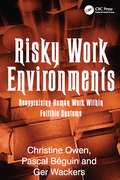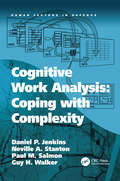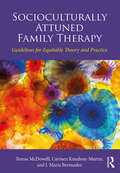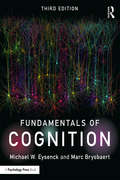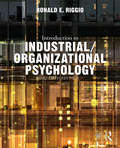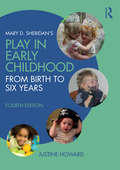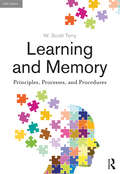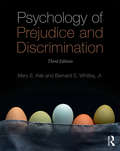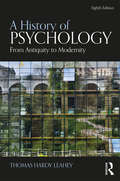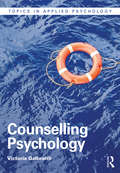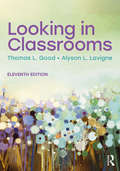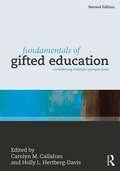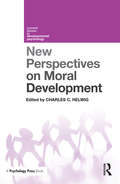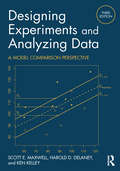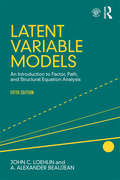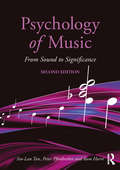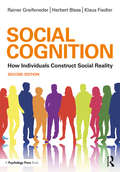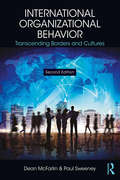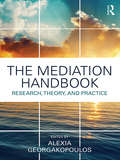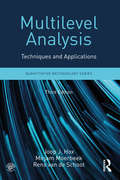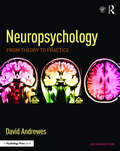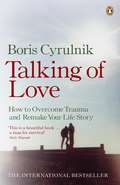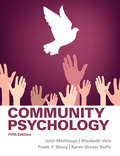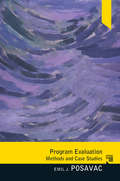- Table View
- List View
Risky Work Environments: Reappraising Human Work Within Fallible Systems
by Pascal BéguinRisky Work Environments provides new insights into the multiple and dynamic trajectories of both near misses and mistakes in complex work environments, based on actual case examples. It also studies the interactions between various activity systems or work practices (design, maintenance, incident investigation, regulation, operation) and their consequences for operational performance. The role of rules and regulations is explored, considering the consequences of deviations and the limitations of enforced compliance. Further, the book explains how to search for, think about and act on information about vulnerability, near misses and mistakes in a way that emphasizes accountability in ways that are not punitive but instead responsible, innovative and provide opportunities for learning. Writing from different disciplines and theoretical perspectives, the contributors analyse working in risky environments which include air traffic control, offshore mining, chemical plants, neo-natal intensive care units, ship piloting and emergency call dispatch centres. In each chapter the authors present rich empirical data and their analyses illustrate a variety of ways in which, despite imperfect systems, safety and resilience is created in human action. In the chapters where the focus is on error or mistakes, the analysis undertaken reveals the logic of actions undertaken at the time as well as their constraints. The contributors are all active researchers within their disciplines and come from Australia, Finland, France, Norway and the Netherlands. The book will be of direct interest to safety scientists, researchers and scientists, as well as human factors practitioners working in complex technological systems.
Cognitive Work Analysis: Coping with Complexity (Human Factors in Defence)
by Daniel P. Jenkins Neville A. Stanton Guy H. Walker'Complex sociotechnical systems' are systems made up of numerous interacting parts, both human and non-human, operating in dynamic, ambiguous and safety critical domains. Cognitive Work Analysis (CWA) is a structured framework specifically developed for considering the development and analysis of these complex socio-technical systems. Unlike many human factors approaches, CWA does not focus on how human-system interaction should proceed (normative modelling) or how human-system interaction currently works (descriptive modelling). Instead, through a focus on constraints, it develops a model of how work can be conducted within a given work domain, without explicitly identifying specific sequences of actions (formative modelling). The framework leads the analyst to consider the environment the task takes place within, and the effect of the imposed constraints on the way work can be conducted. It provides guidance through the process of answering the questions of why the system exists, what activities can be conducted within the domain as well as how these activities can be achieved, and who can perform them. The first part of the book contains a comprehensive description of CWA, introducing it to the uninitiated. It then presents a number of applications in complex military domains to explore and develop the benefits of CWA. Unlike much of the previous literature, particular attention is placed on exploring the CWA framework in its entirety. This holistic approach focuses on the system environment, the activity that takes place within it, the strategies used to conduct this activity, the way in which the constituent parts of the system (both human and non-human) interact and the behaviour required. Each stage of this analysis identifies the constraints governing the system; it is contended that through this holistic understanding of constraints, recommendations can be made for the design of system interaction; increasing the ability of users to cope with unanticipated, unexpected situations. This book discusses the applicability of the approach in system analysis, development and evaluation. It provides process to what was previously a loosely defined framework.
Socioculturally Attuned Family Therapy: Guidelines for Equitable Theory and Practice
by Teresa McDowell Carmen Knudson-Martin J. Maria BermudezSocioculturally Attuned Family Therapy addresses the need for socially responsible couple, marriage, and family therapy that infuses diversity, equity, and inclusion throughout theory and clinical practice. The text begins with a discussion of societal systems, diversity, and socially just practice. The authors then integrate principles of societal context, power, and equity into the core concepts of ten major family therapy models, paying close attention to the "how to’s" of change processes through a highly diverse range of case examples. The text concludes with descriptions of integrative, equity-based family therapy guidelines that clinicians can apply to their practice.
Fundamentals of Cognition
by Michael W. Eysenck Marc BrysbaertIs it possible to learn something without being aware of it?How does emotion influence the way we think?How can we improve our memory? Fundamentals of Cognition, third edition, provides a basic, reader-friendly introduction to the key cognitive processes we use to interact successfully with the world around us. Our abilities in attention, perception, learning, memory, language, problem solving, thinking, and reasoning are all vitally important in enabling us to cope with everyday life. Understanding these processes through the study of cognitive psychology is essential for understanding human behaviour. This edition has been thoroughly updated and revised with an emphasis on making it even more accessible to introductory-level students. Bringing on board Professor Marc Brysbaert, a world-leading researcher in the psychology of language, as co-author, this new edition includes: developed and extended research activities and "In the Real World" case studies to make it easy for students to engage with the material; new real-world topics such as discussions of attention-deficit/hyperactivity disorder, the reading problems of individuals with dyslexia, why magic tricks work, and why we cannot remember the Apple logo accurately; a supporting companion website containing multiple choice questions, flashcards, sample essay answers, instructor resources, and more. The book provides a perfect balance between traditional approaches to cognition and cutting-edge cognitive neuroscience and cognitive neuropsychology. Covering all the key topics within cognition, this comprehensive overview is essential reading for all students of cognitive psychology and related areas such as clinical psychology.
Introduction to Industrial/Organizational Psychology
by Ronald E. RiggioIntroduction to Industrial/Organizational Psychology provides an accessible approach to psychological theory and its applications to the world of work. Using both classic theories and research along with the latest developments and innovations, this student-centered text shows practical applications of theoretical concepts using examples from work situations that students may be familiar with—such as service industries, internet companies, and startups—in addition to traditional office and factory work settings. Each chapter includes key terms and review questions, and the text features special sections highlighting applications of I/O psychology theories, psychological approaches to everyday work situations, and current areas of research and practice. The seventh edition is thoroughly updated to include the latest research on each key topic. It also includes expanded coverage of international issues, job engagement, and emerging topics in the field, such as workplace bullying, virtual teams and organizations, agile organization structures, and web-based training and assessment. The book will be of interest to undergraduate students in introductory I/O psychology or psychology of work behavior courses. For additional resources, please consult the Companion Website at www.routledge.com/cw/riggio, where instructors will find an expanded instructor’s manual, test bank, and lecture slides, and students will find chapter summaries and learning objectives. Ronald E. Riggio is the Henry R. Kravis Professor of Leadership and Organizational Psychology at Claremont McKenna College. He has published nearly two-dozen authored or edited books and more than 150 articles and book chapters.
Mary D. Sheridan's Play in Early Childhood: From Birth to Six Years
by Justine HowardMary D. Sheridan’s Play in Early Childhood is a classic introductory text to play and development – key topics for all those who work with young children. Drawing on the most up-to-date evidence, it explains how children’s play develops and how they develop as they play. With over 100 illustrations and observations of play from birth to six years, this new edition presents classical and contemporary literature, making clear links between play and all areas of children’s development. It includes updated activities to consolidate thinking and suggestions for further reading throughout. This text considers: the development, value and characteristics of play issues relating to culture, adversity, gender, attachment and brain development play from recreational, therapeutic and educational perspectives the role of parents/caregivers and professionals in supporting play how to develop observation and reflection skills for use in your own practice Suitable both for those new to the area and for more experienced workers wanting a quick reference guide, this easy-to-follow book meets the needs of students and professionals from a wide range of health, education and social care backgrounds, including early years professionals, playworkers, children’s nurses, play therapists and social workers.
Learning and Memory: Basic Principles, Processes, and Procedures, Fifth Edition
by W. Scott TerryThis thoroughly updated edition provides a balanced review of the core methods and the latest research on animal learning and human memory. The relevance of basic principles is highlighted throughout via everyday examples to ignite student interest, along with more traditional examples from human and animal laboratory studies. Individual differences in age, gender, learning style, cultural background, or special abilities (such as the math gifted) are highlighted within each chapter to help students see how the principles may be generalized to other subject populations. The basic processes of learning – such as classical and instrumental conditioning and encoding and storage in long-term memory in addition to implicit memory, spatial learning, and remembering in the world outside the laboratory – are reviewed. The general rules of learning are described along with the exceptions, limitations, and best applications of these rules. The relationship between the fields of neuropsychology and learning and memory is stressed throughout. The relevance of this research to other disciplines is reflected in the tone of the writing and is demonstrated through a variety of examples from education, neuropsychology, rehabilitation, psychiatry, nursing and medicine, I/O and consumer psychology, and animal behavior. Each chapter begins with an outline and concludes with a detailed summary. A website for instructors and students accompanies the book. Updated throughout with new research findings and examples the new edition features: A streamlined presentation for today’s busy students. As in the past, the author supports each concept with a research example and real-life application, but the duplicate example or application now appears on the website so instructors can use the additional material to illustrate the concepts in class. Expanded coverage of neuroscience that reflects the current research of the field including aversive conditioning (Ch. 5) and animal working memory (Ch. 8). More examples of research on student learning that use the same variables discussed in the chapter, but applies them in a classroom or student’s study environment. This includes research that applies encoding techniques to student learning, for example: studying: recommendations from experts (Ch. 1); the benefits of testing (Ch. 9); and Joshua Foer’s Moonwalking with Einstein, on his quest to become a memory expert (Ch. 6). More coverage of unconscious learning and knowledge (Ch. 11). Increased coverage of reinforcement and addiction (Ch. 4), causal and language learning (Ch. 6), working memory (WM) and the effects of training on WM, and the comparative evolution of WM in different species (Ch. 8), and genetics and learning (Ch. 12).
Psychology of Prejudice and Discrimination: 3rd Edition
by Bernard E. Whitley Jr. Mary E. KiteThe Psychology of Prejudice and Discrimination provides a comprehensive and compelling overview of what psychological theory and research have to say about the nature, causes, and reduction of prejudice and discrimination. It balances a detailed discussion of theories and selected research with applied examples that ensure the material is relevant to students. Newly revised and updated, this edition addresses several interlocking themes, such as research methods, the development of prejudice in children, the relationship between prejudice and discrimination, and discrimination in the workplace, which are developed in greater detail than in other textbooks. The first theme introduced is the nature of prejudice and discrimination, which is followed by a discussion of research methods. Next comes the psychological underpinnings of prejudice: the nature of stereotypes, the conditions under which stereotypes influence responses to other people, contemporary theories of prejudice, and how values and belief systems are related to prejudice. Explored next are the development of prejudice in children and the social context of prejudice. The theme of discrimination is developed via discussions of the nature of discrimination, the experience of discrimination, and specific forms of discrimination, including gender, sexual orientation, age, ability, and appearance. The concluding theme is the reduction of prejudice. An ideal core text for junior and senior college students who have had a course in introductory psychology, it is written in a style that is accessible to students in other fields including education, social work, business, communication studies, ethnic studies, and other disciplines. In addition to courses on prejudice and discrimination, this book is also adapted for courses that cover topics in racism and diversity. For additional resources, consult the website BreakingPrejudice.org, which focuses on pedagogical materials that can be used to address both cultural awareness and self-awareness of prejudice and to increase students’ multicultural competence. Specifically, the site includes: Original teaching activities (ready to use with minimal preparation, including discussion questions) An annotated list of podcasts (categorized by topic) An annotated list of videos (categorized by topic) A set of social justice songs (categorized by topic) Four original public service announcements 16 video diaries about people’s personal experience with prejudice Interviews with 13 social justice activists
A History of Psychology: From Antiquity to Modernity
by Thomas Hardy LeaheyA History of Psychology places social, economic, and political forces of change alongside psychology’s internal theoretical and empirical arguments, illuminating how the external world has shaped psychology’s development, and, in turn, how the late twentieth century’s psychology has shaped society. Featuring extended treatment of important movements such as the Enlightenment and the Scientific Revolution, the textbook approaches the material from an integrative rather than wholly linear perspective. The text carefully examines how issues in psychology reflect and affect concepts that lie outside the field of psychology’s technical concerns as a science and profession. This new edition features expanded attention on psychoanalysis after its founding as well as new developments in cognitive science, artificial intelligence, and behavioral economics. Throughout, the book strengthens its exploration of psychological ideas and the cultures in which they developed and reinforces the connections between psychology, modernism, and postmodernism. The textbook covers scientific, applied, and professional psychology, and is appropriate for higher-level undergraduate and graduate students.
Counselling Psychology (Topics in Applied Psychology)
by Victoria GalbraithThis is the first textbook to provide a complete overview of counselling psychology. Covering not only the underlying principles and philosophy of the profession, it offers a uniquely applied perspective in a concise, student-friendly format. From the relationship between research and practice to key ethical and professional issues, the book is written by some of the most eminent academic and practising psychologists in the field. It initially defines what counselling psychology and a therapeutic relationship involves, before outlining the range of approaches that can be taken with clients, from CBT to psychodynamic perspectives, and the journey of training through to working as a counselling psychologist. Supported by case studies and a range of features to illustrate how theory can be applied to practice, this is the ideal companion for courses in applied counselling psychology. The integrated and interactive approach covers the personal and professional issues which counselling psychologists face, making this the definitive introduction for any student of this growing field of study.
Looking in Classrooms
by Thomas L. Good Alyson L. LavigneLooking in Classrooms uses educational, psychological, and social science theories and classroom-based research to teach future classroom teachers about the complexities and demands of classroom instruction. While maintaining the core approach of the first ten editions, the book has been thoroughly revised and updated with new research-based content on teacher evaluation, self-assessment, and decision-making; special emphases on teaching students from diverse ethnic, cultural, class, and gender-identity contexts; and rich suggestions for integrating technology into classroom instruction. Widely considered to be the most comprehensive and authoritative source available on effective, successful teaching, Looking in Classrooms synthesizes the knowledge base on student motivation, classroom management, teacher expectations, teacher effectiveness, adaptive instruction for individual learners, and informative observational techniques for enhancing teaching. It addresses key topics in classroom instruction in an accessible fashion, promoting easy intepretation and transfer to practice, and articulates the roles of teacher-centered pedagogy, student-centered instruction, and project-based learning in today‘s classroom. Guided by durable historical knowledge as well as dynamic, emerging conceptions of teaching, this text is ideal for undergraduate teacher training programs and for masters-level courses for teachers, administrators, and superintendents.
Fundamentals of Gifted Education: Considering Multiple Perspectives
by Carolyn M. Callahan Holly L. Hertberg-DavisThe field of gifted education is characterized by a perplexing array of perspectives concerning such fundamental issues as definition, identification, curriculum, social and emotional development, and underserved populations. Fundamentals of Gifted Education provides a coherent framework for planning effective programs, providing appropriate educational services, and evaluating programs for the gifted. Parts are organized around fundamental issues confronting the field and follow a common structure: an introductory chapter that provides an overview of the theme of that part as well as guiding points and questions for the reader followed by representative point-of-view chapters written by leading experts that provide varied perspectives on the topic at hand.
New Perspectives on Moral Development (Current Issues in Developmental Psychology)
by Charles C. HelwigThis volume presents a selection of some of the most exciting new perspectives on moral development that have emerged over the last decade and have transformed our understanding of the field. The contributors to this book cut across traditional boundaries to provide an innovative and integrative approach to fundamental questions dealing with the nature and acquisition of morality. In addressing these questions, the chapters draw on new work on the origins of morality in infancy and the early years, comparative approaches examining morality in primates, new perspectives on moral emotions such as guilt and empathy, and new perspectives on the emerging moral self in childhood and moral identity in adolescence. The book also examines the roles of parenting and culture in children’s and adolescents’ moral development. Each chapter is framed in theory and methodology and provides illustrative examples of new research to address important questions in the field. This book is essential reading for researchers and advanced undergraduate and postgraduate students studying moral development and developmental psychology. It will also be of interest to academics and professionals in related fields such as education and public policy.
Designing Experiments and Analyzing Data: A Model Comparison Perspective, Third Edition
by Scott E. Maxwell Harold D. Delaney Ken KelleyDesigning Experiments and Analyzing Data: A Model Comparison Perspective (3rd edition) offers an integrative conceptual framework for understanding experimental design and data analysis. Maxwell, Delaney, and Kelley first apply fundamental principles to simple experimental designs followed by an application of the same principles to more complicated designs. Their integrative conceptual framework better prepares readers to understand the logic behind a general strategy of data analysis that is appropriate for a wide variety of designs, which allows for the introduction of more complex topics that are generally omitted from other books. Numerous pedagogical features further facilitate understanding: examples of published research demonstrate the applicability of each chapter’s content; flowcharts assist in choosing the most appropriate procedure; end-of-chapter lists of important formulas highlight key ideas and assist readers in locating the initial presentation of equations; useful programming code and tips are provided throughout the book and in associated resources available online, and extensive sets of exercises help develop a deeper understanding of the subject. Detailed solutions for some of the exercises and realistic data sets are included on the website (DesigningExperiments.com). The pedagogical approach used throughout the book enables readers to gain an overview of experimental design, from conceptualization of the research question to analysis of the data. The book and its companion website with web apps, tutorials, and detailed code are ideal for students and researchers seeking the optimal way to design their studies and analyze the resulting data.
Latent Variable Models: An Introduction to Factor, Path, and Structural Equation Analysis, Fifth Edition
by John C. Loehlin A. Alexander BeaujeanLatent Variable Models: An Introduction to Factor, Path, and Structural Equation Analysis introduces latent variable models by utilizing path diagrams to explain the relationships in the models. This approach helps less mathematically-inclined readers to grasp the underlying relations among path analysis, factor analysis, and structural equation modeling, and to set up and carry out such analyses. This revised and expanded fifth edition again contains key chapters on path analysis, structural equation models, and exploratory factor analysis. In addition, it contains new material on composite reliability, models with categorical data, the minimum average partial procedure, bi-factor models, and communicating about latent variable models. The informal writing style and the numerous illustrative examples make the book accessible to readers of varying backgrounds. Notes at the end of each chapter expand the discussion and provide additional technical detail and references. Moreover, most chapters contain an extended example in which the authors work through one of the chapter’s examples in detail to aid readers in conducting similar analyses with their own data. The book and accompanying website provide all of the data for the book’s examples as well as syntax from latent variable programs so readers can replicate the analyses. The book can be used with any of a variety of computer programs, but special attention is paid to LISREL and R. An important resource for advanced students and researchers in numerous disciplines in the behavioral sciences, education, business, and health sciences, Latent Variable Models is a practical and readable reference for those seeking to understand or conduct an analysis using latent variables.
Psychology of Music: From Sound to Significance
by Siu-Lan Tan Peter Pfordresher Rom HarréIn Psychology of Music: From Sound to Significance (2nd edition), the authors consider music on a broad scale, from its beginning as an acoustical signal to its different manifestations across cultures. In their second edition, the authors apply the same richness of depth and scope that was a hallmark of the first edition of this text. In addition, having laid out the topography of the field in the original book, the second edition puts greater emphasis on linking academic learning to real-world contexts, and on including compelling topics that appeal to students’ natural curiosity. Chapters have been updated with approximately 500 new citations to reflect advances in the field. The organization of the book remains the same as the first edition, while chapters have been updated and often expanded with new topics. 'Part I: Foundations' explores the acoustics of sound, the auditory system, and responses to music in the brain. 'Part II: The Perception and Cognition of Music' focuses on how we process pitch, melody, meter, rhythm, and musical structure. 'Part III: Development, Learning, and Performance' describes how musical capacities and skills unfold, beginning before birth and extending to the advanced and expert musician. And finally, 'Part IV: The Meaning and Significance of Music' explores social, emotional, philosophical and cultural dimensions of music and meaning. This book will be invaluable to undergraduates and postgraduate students in psychology and music, and will appeal to anyone who is interested in the vital and expanding field of psychology of music.
Social Cognition: How Individuals Construct Social Reality
by Rainer Greifeneder Herbert Bless Klaus FiedlerSocial cognition is a key area of social psychology, which focuses on cognitive processes that are involved when individuals make sense of, and navigate in their social world. For instance, individuals need to understand what they perceive, they learn and recall information from memory, they form judgments and decisions, they communicate with others, and they regulate their behavior. While all of these topics are also key to other fields of psychological research, it’s the social world—which is dynamic, complex, and often ambiguous—that creates particular demands. This accessible book introduces the basic themes within social cognition and asks questions such as: How do individuals think and feel about themselves and others? How do they make sense of their social environment? How do they interact with others in their social world? The book is organized along an idealized sequence of social information processing that starts at perceiving and encoding, and moves on to learning, judging, and communicating. It covers not only processes internal to the individual, but also facets of the environment that constrain cognitive processing. Throughout the book, student learning is fostered with examples, additional materials, and discussion questions. With its subdivision in ten chapters, the book is suitable both for self-study and as companion material for those teaching a semester-long course. This is the ideal comprehensive introduction to this thriving and captivating field of research for students of psychology.
International Organizational Behavior: Transcending Borders and Cultures
by Dean McFarlin Paul SweeneyThis book focuses on understanding and managing organizational behavior in an international context, considering the conceptual framework of culture and offering practical advice for navigating cultures in the workplace. Readers will gain new tools to interpret behavior, helping them to manage international challenges effectively. The authors outline the critical management and adaptation skills necessary to develop within a globalized organization, teaching the reader how to recruit, coordinate, and evaluate an international team. Updated "Culture Clash" and "Global Innovations" boxes provide important insights into identifying a core set of values to "customize" management techniques across cultures, focusing particularly on growing countries like India and China. The new edition features a more streamlined chapter structure, updated discussion questions, and new end-of-chapter cases with self-scoring quizzes for further development. International Organizational Behavior will prove a valuable resource for any student of organizational behavior, international management, and international business. A companion website provides additional support for instructors, featuring an instructor’s manual, test bank, and PowerPoint slides.
The Mediation Handbook: Research, theory, and practice
by Alexia GeorgakopoulosThe Handbook of Mediation gathers leading experts across fields related to peace, justice, human rights, and conflict resolution to explore ways that mediation can be applied to a range of spectrums, including new age settings, relationships, organizations, institutions, communities, environmental conflicts, and intercultural and international conflicts. The text is informed by cogent theory, state-of-the-art research, and best practices to provide the reader with a well-rounded understanding of mediation practice in contemporary times. Based on four signature themes—contexts; skills and competencies; applications; and recommendations—the handbook provides theoretical, applicable, and practical insight into a variety of key approaches to mediation. Authors consider modern conflict on a local and global scale, emphasizing the importance of identifying effective strategies, foundations, and methods to shape the nature of a mediation mindfully and effectively. With a variety of interdisciplinary perspectives, the text complements the development of the reader’s competencies and understanding of mediation in order to contribute to the advancement of the mediation field. With a conversational tone that will welcome readers, this comprehensive book is essential reading for students and professionals wanting to learn a wide range of potential interventions for conflict.
Multilevel Analysis: Techniques and Applications, Third Edition (Quantitative Methodology Series )
by Joop J. Hox Mirjam Moerbeek Rens van de SchootApplauded for its clarity, this accessible introduction helps readers apply multilevel techniques to their research. The book also includes advanced extensions, making it useful as both an introduction for students and as a reference for researchers. Basic models and examples are discussed in nontechnical terms with an emphasis on understanding the methodological and statistical issues involved in using these models. The estimation and interpretation of multilevel models is demonstrated using realistic examples from various disciplines including psychology, education, public health, and sociology. Readers are introduced to a general framework on multilevel modeling which covers both observed and latent variables in the same model, while most other books focus on observed variables. In addition, Bayesian estimation is introduced and applied using accessible software.
Neuropsychology: From Theory to Practice
by David AndrewesThe second edition of this comprehensive textbook for students of Neuropsychology gives a thorough overview of the complex relationship between brain and behaviour. With an excellent blend of clinical, experimental and theoretical coverage, it draws on the latest research findings from neuroscience, cognitive neuroscience, neurochemistry, clinical neuropsychology and neuropsychology to provide students with new insights in this fast moving field. The book is organised around the main neuropsychological disorders in the areas of perception, executive dysfunction, attention, memory, cerebral asymmetry, language, emotion and consciousness. There is a clear emphasis on bridging the gap between theory and practice with links throughout to clinical issues of both assessment and rehabilitation to build a clear understanding of the application of the theoretical issues. The final section in each chapter illustrates the importance of a more systematic approach to intervention, which takes into account theoretical views of recovery from brain damage. New to this edition: A new chapter format that includes a "basic topic" section, which contains up-to-date essential knowledge of the topic and a "further topics" section for a more advanced treatment of the area. A new section on neuroscientific approaches to rehabilitation in each chapter to make links between scientific knowledge and clinical treatment. A brand new chapter on consciousness A new full colour layout with increased pedagogical features, including key terms, section summaries, ‘study questions’ and improved presentation of figures and brain diagrams A companion website including related weblinks, guidance on answering the ‘study questions’, and flashcards. This book will be invaluable for undergraduate students in Neuropsychology and students who wish to take the subject further to the various clinical fields.
Talking of Love: How to Overcome Trauma and Remake Your Life Story
by Boris Cyrulnik David MaceyAll of us suffer traumatic experiences in our lives, whether it is losing someone close, the end of a love affair or a violent event. Yet we need not be controlled by our pain. Psychoanalyst Boris Cyrulnik, himself a survivor of great trauma, has worked with victims of cruelty and disaster all over the world. Here he draws on a mixture of case histories, parables and personal recollections to explain how - at any stage of life - it is possible to break free from tragedy by translating our suffering into words and creating a place where emotions can be expressed. Talking of Love shows that our pain does not have to be our destiny - and that life stories can be rewritten.
Community Psychology: Fifth Edition
by Karen Grover Duffy Frank Y Wong Elizabeth Vera John MoritsuguCommunity Psychology, 5/e focuses on the prevention of problems, the promotion of well-being, empowerment of members within a community, the appreciation of diversity, and an ecological model for the understanding of human behavior. Attention is paid to both “classic” early writings and the most recent journal articles and reviews by today’s practitioners and researchers. Historical and alternative methods of effecting social change are explored in this book, with the overall theme that the environment is as important as the individual in it.This text is available in a variety of formats – digital and print. Learning Goals Upon completing this book, readers will be able to: Understand the historical and contemporary principles of community psychology. Apply theory and research to social services, mental health, health, legal, and public health systems
Program Evaluation: Methods and Case Studies (Mysearchlab Series 15% Off Ser.)
by Emil J. PosavacComprehensive yet accessible, this text provides a practical introduction to the skills, attitudes, and methods required to assess the worth and value of human services offered in public and private organizations in a wide range of fields. Students are introduced to the need for such activities, the methods for carrying out evaluations, and the essential steps in organizing findings into reports. The text focuses on the work of people who are closely associated with the service to be evaluated, and is designed to help program planners, developers, and evaluators to work with program staff members who might be threatened by program evaluation.
Program Evaluation: Methods and Case Studies
by Emil J. PosavacComprehensive yet accessible, this text provides a practical introduction to the skills, attitudes, and methods required to assess the worth and value of human services offered in public and private organizations in a wide range of fields. Students are introduced to the need for such activities, the methods for carrying out evaluations, and the essential steps in organizing findings into reports. The text focuses on the work of people who are closely associated with the service to be evaluated, and is designed to help program planners, developers, and evaluators to work with program staff members who might be threatened by program evaluation.
